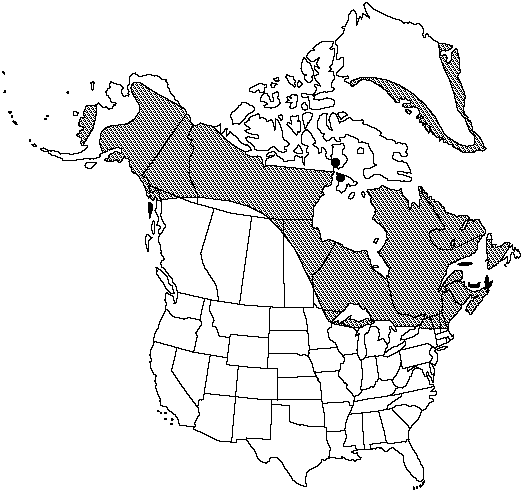Difference between revisions of "Woodsia alpina"
Nat. Arr. Brit. Pl. 2: 17. 1821.
FNA>Volume Importer |
FNA>Volume Importer |
||
| Line 32: | Line 32: | ||
}}<!-- | }}<!-- | ||
| − | --><span class="statement" id="st- | + | --><span class="statement" id="st-undefined" data-properties=""><b>Stems </b>compact, erect to ascending, with cluster of persistent petiole bases of ± equal length; scales uniformly brown, lanceolate. <b>Leaves</b> 2.5–20 × 0.5–2.5 cm. <b>Petiole</b> reddish brown or dark purple when mature, articulate above base at swollen node, relatively brittle and easily shattered. <b>Blade</b> linear to narrowly lanceolate, usually pinnate-pinnatifid proximally, lacking glands, never viscid; rachis with widely scattered hairs and scales. <b>Pinnae</b> ovate-lanceolate to deltate, longer than wide, abruptly tapered to a rounded or broadly acute apex; largest pinnae with 1–3 pairs of pinnules; abaxial surface with isolated hairs and linear scales, adaxial surface glabrous. <b>Pinnules</b> entire or broadly crenate; margins nonlustrous, thin, with occasional isolated cilia, lacking translucent projections. <b>Vein</b> tips often enlarged to form whitish hydathodes visible adaxially. <b>Indusia</b> of narrow, hairlike segments, these uniseriate throughout, composed of cells many times longer than wide, usually surpassing mature sporangia. <b>Spores</b> averaging 46–53 µm.</span><!-- |
-->{{Treatment/Body | -->{{Treatment/Body | ||
| + | |phenology=Sporulating summer–early fall. | ||
|habitat=Crevices and ledges on cliffs (occasionally on rocky slopes), mostly slaty and calcareous rocks | |habitat=Crevices and ledges on cliffs (occasionally on rocky slopes), mostly slaty and calcareous rocks | ||
|elevation=0–1500 m | |elevation=0–1500 m | ||
| Line 54: | Line 55: | ||
|basionyms=Acrostichum alpinum | |basionyms=Acrostichum alpinum | ||
|family=Dryopteridaceae | |family=Dryopteridaceae | ||
| + | |phenology=Sporulating summer–early fall. | ||
|habitat=Crevices and ledges on cliffs (occasionally on rocky slopes), mostly slaty and calcareous rocks | |habitat=Crevices and ledges on cliffs (occasionally on rocky slopes), mostly slaty and calcareous rocks | ||
|elevation=0–1500 m | |elevation=0–1500 m | ||
| Line 61: | Line 63: | ||
|publication year=1821 | |publication year=1821 | ||
|special status= | |special status= | ||
| − | |source xml=https://jpend@bitbucket.org/aafc-mbb/fna- | + | |source xml=https://jpend@bitbucket.org/aafc-mbb/fna-data-curation.git/src/9216fc802291cd3df363fd52122300479582ede7/coarse_grained_fna_xml/V2/V2_48.xml |
|genus=Woodsia | |genus=Woodsia | ||
|species=Woodsia alpina | |species=Woodsia alpina | ||
| − | |||
| − | |||
| − | |||
| − | |||
| − | |||
| − | |||
| − | |||
| − | |||
| − | |||
| − | |||
| − | |||
| − | |||
| − | |||
| − | |||
| − | |||
| − | |||
| − | |||
| − | |||
| − | |||
| − | |||
| − | |||
| − | |||
| − | |||
| − | |||
| − | |||
| − | |||
| − | |||
| − | |||
| − | |||
| − | |||
| − | |||
| − | |||
| − | |||
| − | |||
| − | |||
| − | |||
| − | |||
}}<!-- | }}<!-- | ||
-->[[Category:Treatment]][[Category:Woodsia]] | -->[[Category:Treatment]][[Category:Woodsia]] | ||
Revision as of 14:21, 27 July 2019
Stems compact, erect to ascending, with cluster of persistent petiole bases of ± equal length; scales uniformly brown, lanceolate. Leaves 2.5–20 × 0.5–2.5 cm. Petiole reddish brown or dark purple when mature, articulate above base at swollen node, relatively brittle and easily shattered. Blade linear to narrowly lanceolate, usually pinnate-pinnatifid proximally, lacking glands, never viscid; rachis with widely scattered hairs and scales. Pinnae ovate-lanceolate to deltate, longer than wide, abruptly tapered to a rounded or broadly acute apex; largest pinnae with 1–3 pairs of pinnules; abaxial surface with isolated hairs and linear scales, adaxial surface glabrous. Pinnules entire or broadly crenate; margins nonlustrous, thin, with occasional isolated cilia, lacking translucent projections. Vein tips often enlarged to form whitish hydathodes visible adaxially. Indusia of narrow, hairlike segments, these uniseriate throughout, composed of cells many times longer than wide, usually surpassing mature sporangia. Spores averaging 46–53 µm.
Phenology: Sporulating summer–early fall.
Habitat: Crevices and ledges on cliffs (occasionally on rocky slopes), mostly slaty and calcareous rocks
Elevation: 0–1500 m
Distribution

Greenland, B.C., Man., N.B., Nfld., N.W.T., N.S., Ont., Que., Sask., Yukon, Alaska, Maine, Mich., Minn., N.H., N.Y., Vt., n Eurasia.
Discussion
Isozyme studies confirm the longstanding hypothesis that Woodsia alpina is an allotetraploid derived from hybridization between W. glabella and W. ilvensis (see reticulogram). Considerable disagreement exists concerning the chromosome number of W. alpina, but 2n = 160 seems most likely, given the numbers reported for the two parental species. Hybrids between W. alpina and W. ilvensis have been reported from both Europe and North America. These morphologically intermediate triploids with malformed spores have been called W. × gracilis (Lawson) Butters.
Selected References
None.